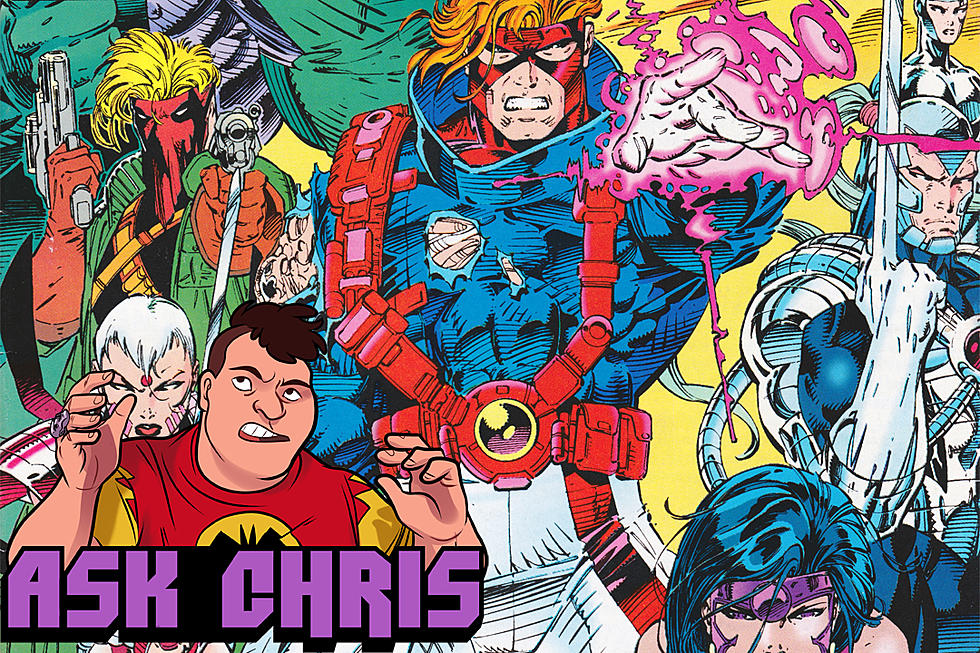
Filthy Assistance: Revisiting ‘Transmetropolitan: Back on the Street’
In the 1990s, the Warren Ellis/Darick Robertson comic series Transmetropolitan foresaw a future full of twisted behavior, renegade politics, and uncontrollable technology. Now that reality seems to have caught up with the adventures of Spider Jerusalem, we at ComicsAlliance are returning to the series and examining what it has to say. Do you need help navigating a political world turned upside down and inside out? We’re here --- with some Filthy Assistance.
This week, we kick the series off with Spider Jerusalem forced by financial distress and contractual obligation to return to the City --- a post-cyberpunk future and an alchemical mix of the ancient and the bleeding edge. He finds a nascent movement in danger of getting its teeth kicked in by authority, attends a religious convention, transforms into a television program, and teaches the president that everything poops.
And with that, Transmetropolitan is off to the races.
Ellis and Robertson’s Transmetropolitan, with inks by Rodney Ramos, Keith Aiken, Jerome K. Moore, Kim DeMulder, Ray Kryssing and Dick Giordano, colors from Nathan Eyring, and letters by Clem Robins, came out a couple of years after Preacher, and was considered a sibling series of sorts, down to Garth Ennis writing the introduction to the first volume. It’s not hard to see why, with both taking a stance of sharpened cussedness at a world where myths inevitably turned out fraudulent and the truth was at a premium.
Transmetropolitan was about how the future was still going to have liars and crooks, in much the way Preacher was about how the past was propped up by con men and sin. It’s no wonder there were comparisons. But they were also very distinct, creating that phenomenon where odds were good that if you read one, you read both, and you were always up for a discussion as to which one was better.
One point in Transmetropolitan’s favor is that Warren Ellis, writing tics and all, was very good at charting the trajectory of future technological progress and how it would accelerate --- but not fundamentally change --- human nature. Consequently, large chunks of Transmetropolitan feel like the world has caught up to the fiction --- the word “feed” to mean an information stream has entered common usage, and I predict we’re about five years away from a puppet show about sex positivity (assuming YouTube hasn’t stepped up already in some corner that’s passed outside my sight.)
So much of the storytelling in the series comes from the art team, led by Robertson. They pack the world with interesting touches, most notably the way that much of the world is a combination of old technology kept around because it hasn’t needed improvement, and technology you’d expect from a post-cyberpunk world. There’s brain-taped personalities downloaded to nanotech foglets, and also cradle-style corded phones. Spider is clearly carrying a laptop, but calls it a typewriter, and it has the rounded-style keys found on typewriters made before I was born.
Robertson and the art team also fill the backgrounds with eye-catching ads for television programs, commercial products, and musical acts that often come back into the narrative. A calendar for the aforementioned Sex Puppets…
… pays off when Spider watches it on TV:
Ellis and Robertson understood that comics is a medium where you can spend as much time with each panel as you like, and they make the most use of it with details like this.
They also understood that how we perceive human identity was about to explode; not so much that new identities would be invented, so much as total information connectivity would turn isolated human islands into a connected and self-reinforcing network. We see it with the transients, a group of humans turning into aliens, who are trying to secede from the city and are about to get beaten to death by cops. They could be an analogue for anything from furries to transgender people, and Spider seethes with contempt for them even though he knows they’re harmless.
They are, in the end, undone by a combination of a charismatic leader caught with his pants down and agents provocateurs, an ages-old tactic in which public opinion is turned against movements by having someone infiltrate the movement and engage in violence that is then blamed on the group as a whole. Spider, in one of the books’ most effective moments, tells the City all about this in a column he’s writing “live” --- a combination of live video and written reportage, again combining the new and the old. Spider may hate everyone --- or pretend to --- but he doesn’t hate them equally. He has ire, and he has journalistic ire, and the former is his defense mechanism, but the latter is his weapon.
After the opening, the next three issues are one-shots, each focusing on a different aspect on life in the City of the future. The first has Spider Jerusalem and his newfound filthy assistant, Channon, confronting the current president, known affectionately as the Beast. The Beast is immediately set up to be more cynical than Spider Jerusalem, having reached a peace with a passive populace that Spider never will --- which makes his eventual supplanting as the series’ main villain a bold move.
The second has Spider Jerusalem observing, and then interacting with, the City’s media landscape, and recoiling in horror when he realizes that he’s been dragged back into celebrity culture and made into a news story. It’s a funny palette cleanser, ending with dream advertisements reminiscent of the “blipverts” from the seminal cyberpunk show Max Headroom, and it gives important insight into Spider as a character. He hates being a celebrity, because being a celebrity is to be a story instead of a storyteller, and he believes one can’t be both. Considering how often in our modern era a journalist’s personality and celebrity has overwhelmed their work, he’s not wrong to think this.
Finally, Spider and Channon go to the religious equivalent of Comic Con, in “Did You Know Warren Ellis is an Atheist: The Comic.” One claim frequently made about Transmetropolitan is that Spider Jerusalem was basically an avatar for Warren Ellis’ online persona at the time of its writing, and this is one of those issues where the claim rings true. But it’s still a worthwhile story, because of the scene where Spider realizes that his screw-everyone persona has run over Channon’s feet, and he apologizes.
From all accounts, Warren Ellis is a very nice man, with an abrasive persona as a front to deal with the tornado of anonymous rage that the internet can turn into. What this story reveals is that it’s a front for Spider as well; that deep down he cares, and all his rage at the world is because you can’t be disappointed in something you expect nothing from to begin with.
This more human, thoughtful side of Spider Jerusalem will come to the fore in the next volume, as he tells the forgotten stories of the City. We’ll see you all next time, two weeks into the future.
If you would like to support good journalism --- which never stops being necessary in any era --- these organizations can always use your help:
More From ComicsAlliance

![Jenny Sparks Enters The Scene In Ellis And Davis Hunt’s ‘The Wild Storm’ #3 [Preview]](http://townsquare.media/site/622/files/2017/03/TWS_Cv3_000.png?w=980&q=75)







